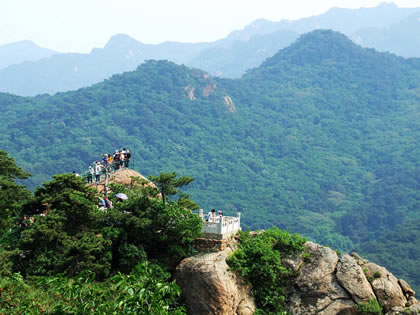スポット

The scenic spot is 2,762m long at 450-550m altitude, most known for rare and strange-shaped peaks, rocks and pines, and is the only alpine tourist attraction in Qianshan Mountain Scenic Area. It features high and steep peaks, jagged rocks, cliffs and scarps, among which pines and cypresses are interspersed. It is home to Wuliang Temple and Zuyue Temple, ranking first among the Taoist Temples and five major Buddhist temples in Qianshan Mountain. There are over 100 famous sights including Parrot-shaped Rock, A-Gleam-of-Sky Path, Sea-Watching Pine, Sky-Watching Stone Frog, Jiuchongtian Peak, Heart-Shaped Rock, Yuxia Pass, Foshou Peak, etc. It is visited by several emperors, for instance, Emperor Taizong of Tang, Li Shimin, Emperor Shizong of Jin, Wanyan Yong, Emperor Kangxi, the Holy Lord of Qing, as well as Emperor Jiaqing, Renzong of Qing.
The Parrot-shaped Rock naturally formed and true to life is the only spot named after birds in Tianshangtian Peak Scenic Spot. Surrounded by ancient pines, topped by verdant leaves, it attracts people by its pretty scenery.
Actually, the A-Gleam-of-Sky Path is a straight and narrow crack between rocks, 32m long, 1m wide and over 10m deep, while the stone path is very steep lying in the crack. Looking up, cliffs on sides look high up in the air, but a glimpse of blue sky comes in sight in the middle, truly impressive.
The Sea-Watching Pine looks strange, standing on the cliff, with two trunks. The one trunk stands erect, while the other bows down, seeming like watching the sea. Such sight impresses everyone as a masterpiece of nature.
As the poem goes “we’d be two love birds flying together on high and two trees with branches interlocked on earth”, Heart-Shaped Rock and Lovers Pines seem like two fiery hearts get close; lovers are infatuated with that and hope for forever-lasting love.
Surrounded by pines and verdant trees, Yuxia Pass seems to be inlaid with a giant pure jade that symbolizes Chinese people’s great reverence and worship for heaven and the earth.
Foshou Peak is a granite column-shaped giant rock and looks like a Buddha’s hand. In the Qing Dynasty, a Buddhist named it Foshou Peak (Buddha’s Hand Peak) after seeing it. Miao Runfu, the Grand Historian of the Qing Dynasty, praised the peak in his poem。
The cableway is the direct way to Tianshangtian Peak for tourists to appreciate marvelous scenery.
With an area of 125 km2, it is titled as the National Park of China of the first batch, National AAAA Tourist Attraction and Top 10 National Civilized Scenic Area of the first batch announced by the State Council.
Qianshan Mountain has a deep religious culture, where the Buddhism and Taoism coexist in harmony, being the largest religious place in the Northeast China. It is home to 9 palaces, 8 temples, 5 major Buddhist temples and 12 thatched nunneries, amounting to nearly 40 temples, such as Longquan Temple, Zuyue Temple, Xiangyan Temple, Zhonghui Temple, Da’an Temple, Wuliang Temple, Palace of Five Dragons, etc. Particularly, the largest Naturally Formed Maitreya Buddha measures 70m high in the world and was inscribed by the former President of the Buddhist Association, Zhao Puchu, with the words ‘Grand Maitreya Buddha of Qianshan Mountain’, and by the Vice President of the World Buddhist Federation, Sik Kok Kwong, with the words ‘Place of Buddhist Rites for Maitreya Buddha’.
Qianshan Mountain Scenic Area welcomes all friends all over the world to come to appreciate the beautiful natural scenery and experience the profound religious culture, and extends bests wishes for all friends.
